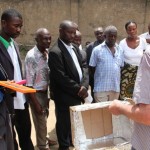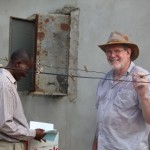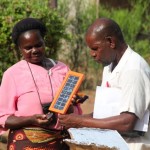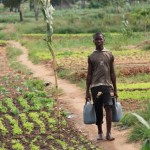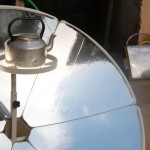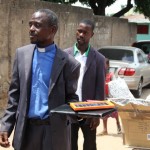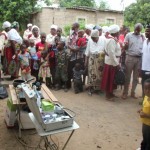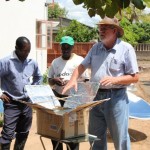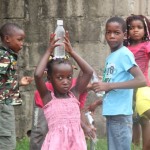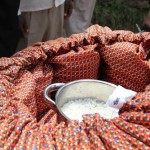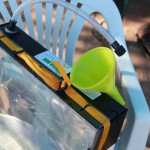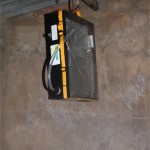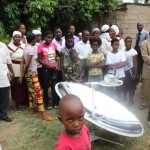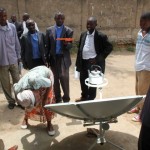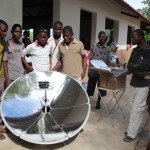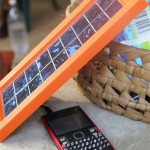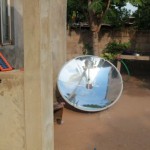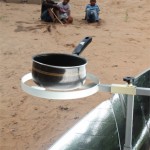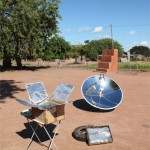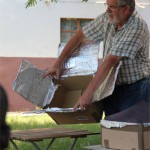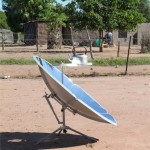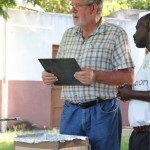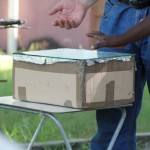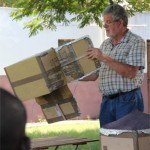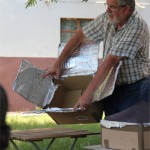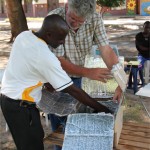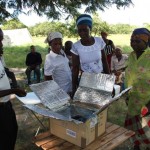My dad runs the Mozambique School of the Bible, providing Christian literature to Bible Schools and Pastors in Mozambique in their local language. We decided to team up and have an outreach with a focus on the environment. We very soon realised that their biggest concern is energy and so we focussed on renewable energy and energy efficiency options that are suitable for the local people. During our time in Mozambique we visited various areas (Maputo, Macia, Xai-Xai, Chokwe area) and did seven educational sessions with different communities.
Most of the people that we met used charcoal for cooking, even in Maputo. About half of the people we met had electricity, which was mostly used for lighting, charging cellphones and maybe for a fridge or TV. In some areas people were using CFLs, while other areas were mostly incandescent lights.
While some of the people had seen photovoltaic (PV) panels, they were generally not accessible and people were amazed to be able to simply plug in and charge their cellphones. All the people were amazed to see how hot the solar stove was and none of them had seen it before.
The following items were showcased:
TSHISA BOX: This small mobile solar water heater is ideal for the locals in Mozambique as it provides hot water at no cost. I had a few warm showers from the Tshisa Box which worked even when it was overcast.
SOLAR COOKER: People were amazed to see how hot it got in a very short period of time and were keen to explore this more. It will work well in areas where there is a shortage of wood or charcoal, if people can would experiment with it and try to use it. More time was needed with local communities so that they could cook with it. Click here for some guidance on how to set up your solar cooker. This solar cooker is available from www.sosolar.co.za
SOLAR PANEL: We had a very nice and robust mobile solar panel, which worked great for charging cellphones or other small appliances. All the people had cellphones and were keen to charge their phones. This item will sell like hotcakes if it was a bit more affordable. This solar panel is available from www.greenafricainitiatives.co.za
WONDERBAG: We made numerous pots of rice in the wonderbag, which I often use at my home for cooking. I love my wonderbag and explained this to the locals as a thermos for food. I recommend www.nb-wonderbag.com
INDUCTION STOVE: I took my induction stove from home along to simply showcase how energy efficient it is, specifically where energy is limited. The purpose of this was to showcase new technology so that people can see that time are changing. I got my stove from Ellies at Builders Warehouse and was pleased to see new BuildersWarehouse stores opening in Xhi-Xhi, Tete and Maputo.
ENERY EFFICIENT LIGHTS: I also showcased different types of lights so that people can see how much power they use. We showed them incandescent (dinosaur) lights which use a lot of energy, compact fluorescent lights (CFLs), which are energy savers, and also light emitting diodes (LEDs) which are the most energy efficient.
SOLAR OVEN: In an attempt to showcase how people can make their own solar stoves my dad built one from cardboard boxes, tin foil, a glass top and some insulation. People were positive to try to make this themselves and felt that it was affordable and not too difficult.
- The inner box, with tin foil. Place a metal plate in the box to catch extra heat
- The glass needs to cover the inner box
- Make sure the boxes are strong and secure
- The outer box needs tin foil on lids to reflect the sun into the box
- Place the inner box into the outer box, with the metal at the bottom and the glass on top
- Place it in the sun to catch the heat.
NEW INNOVATION FOR SAFE DRINKING WATER THROUGH SUN POWER:
Following on my visit to Mozambique I have come across another very useful item which I would like to share with the people that I met. I have not seen it myself, but it comes recommended, makes sense to me and address the concern around safe drinking water.
Solvatten makes unsafe water drinkable by using solar energy. Put Solvatten in a sunny place, give it 2-6 hours and the water will be drinkable. This can be done once, twice, sometimes four times a day, producing 11- 44 liters.
It is common knowledge that boiling can make water safe to drink. But it is not as widely known that UV light also kills micro-organisms. Solvatten is a specially designed container that uses heat, UV and a built-in filter to clean contaminated water. The patented Swedish invention Solvatten inactivates micro-organisms that cause diarrhoea and disease, producing water which meets the WHO’s Guidelines for Safe Water (<1 E-coli/100ml water).
Solvatten can treat water containing bacteria, viruses and parasites. Solvatten don’t use the aid of any chemicals or any energy-source except the sun. Treated with care you can expect approximately 7 years of trouble-free use. Solvatten has an indicator that shows the user that the water treatment process is complete.
Use of Solvatten does not require purchase of any supplies or spare parts. The filter can easily be removed for cleaning, and can be replaced by several layers of a fine local cloth. The outside of the Solvatten unit should be rinsed or wiped, without detergent, and the inside can be cleaned with some locally-produced wool balls or a handful of rice/beans, and a little water.
Limitations
Salty water cannot be made drinkable in Solvatten, neither can chemical pollutants from industry be removed. If arsenic, iron or fluorides are naturally present in the water then another water treatment solution should be used prior to treatment in Solvatten. For more information visit their website at www.solvatten.se

